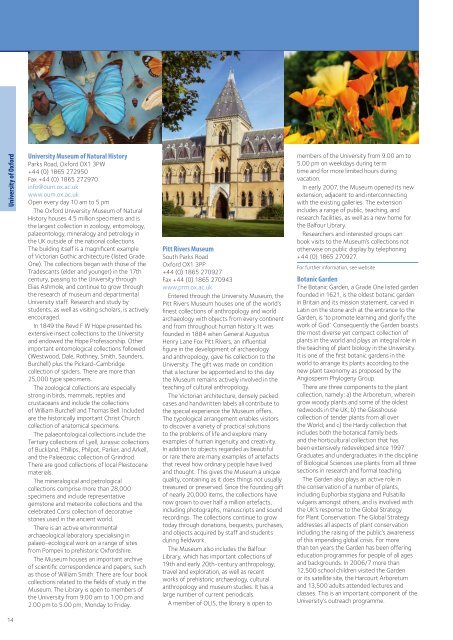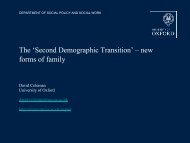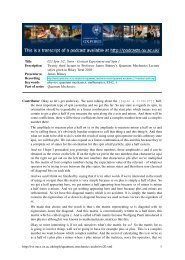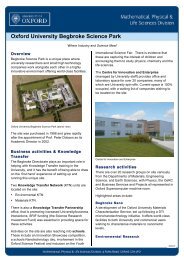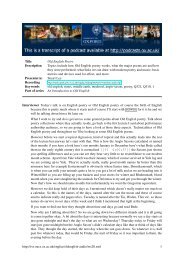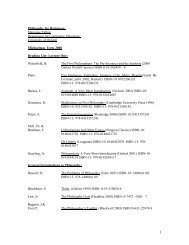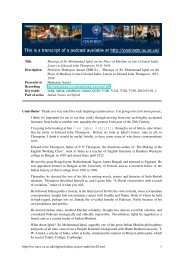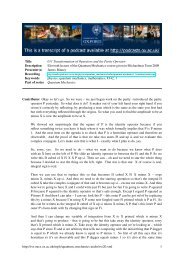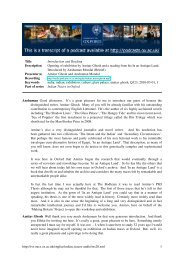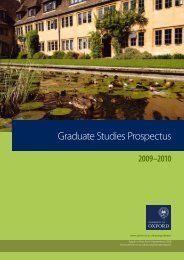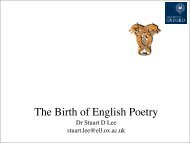Graduate Studies Prospectus - University of Oxford
Graduate Studies Prospectus - University of Oxford
Graduate Studies Prospectus - University of Oxford
Create successful ePaper yourself
Turn your PDF publications into a flip-book with our unique Google optimized e-Paper software.
Sparks 68Greg Smolonski<strong>University</strong> <strong>of</strong> <strong>Oxford</strong><strong>University</strong> Museum <strong>of</strong> Natural HistoryParks Road, <strong>Oxford</strong> OX1 3PW+44 (0) 1865 272950Fax +44 (0) 1865 272970info@oum.ox.ac.ukwww.oum.ox.ac.ukOpen every day 10 am to 5 pmThe <strong>Oxford</strong> <strong>University</strong> Museum <strong>of</strong> NaturalHistory houses 4.5 million specimens and isthe largest collection in zoology, entomology,palaeontology, mineralogy and petrology inthe UK outside <strong>of</strong> the national collections.The building itself is a magnificent example<strong>of</strong> Victorian Gothic architecture (listed GradeOne). The collections began with those <strong>of</strong> theTradescants (elder and younger) in the 17thcentury, passing to the <strong>University</strong> throughElias Ashmole, and continue to grow throughthe research <strong>of</strong> museum and departmental<strong>University</strong> staff. Research and study bystudents, as well as visiting scholars, is activelyencouraged.In 1849 the Revd F W Hope presented hisextensive insect collections to the <strong>University</strong>and endowed the Hope Pr<strong>of</strong>essorship. Otherimportant entomological collections followed(Westwood, Dale, Rothney, Smith, Saunders,Burchell) plus the Pickard-Cambridgecollection <strong>of</strong> spiders. There are more than25,000 type specimens.The zoological collections are especiallystrong in birds, mammals, reptiles andcrustaceans and include the collections<strong>of</strong> William Burchell and Thomas Bell. Includedare the historically important Christ Churchcollection <strong>of</strong> anatomical specimens.The palaeontological collections include theTertiary collections <strong>of</strong> Lyell, Jurassic collections<strong>of</strong> Buckland, Phillips, Philpot, Parker, and Arkell,and the Palaeozoic collection <strong>of</strong> Grindrod.There are good collections <strong>of</strong> local Pleistocenematerials.The mineralogical and petrologicalcollections comprise more than 28,000specimens and include representativegemstone and meteorite collections and thecelebrated Corsi collection <strong>of</strong> decorativestones used in the ancient world.There is an active environmentalarchaeological laboratory specialising inpalaeo-ecological work on a range <strong>of</strong> sitesfrom Pompeii to prehistoric <strong>Oxford</strong>shire.The Museum houses an important archive<strong>of</strong> scientific correspondence and papers, suchas those <strong>of</strong> William Smith. There are four bookcollections related to the fields <strong>of</strong> study in theMuseum. The Library is open to members <strong>of</strong>the <strong>University</strong> from 9.00 am to 1.00 pm and2.00 pm to 5.00 pm, Monday to Friday.Pitt Rivers MuseumSouth Parks Road<strong>Oxford</strong> OX1 3PP+44 (0) 1865 270927Fax +44 (0) 1865 270943www.prm.ox.ac.ukEntered through the <strong>University</strong> Museum, thePitt Rivers Museum houses one <strong>of</strong> the world’sfinest collections <strong>of</strong> anthropology and worldarchaeology with objects from every continentand from throughout human history. It wasfounded in 1884 when General AugustusHenry Lane Fox Pitt Rivers, an influentialfigure in the development <strong>of</strong> archaeologyand anthropology, gave his collection to the<strong>University</strong>. The gift was made on conditionthat a lecturer be appointed and to this daythe Museum remains actively involved in theteaching <strong>of</strong> cultural anthropology.The Victorian architecture, densely packedcases and handwritten labels all contribute tothe special experience the Museum <strong>of</strong>fers.The typological arrangement enables visitorsto discover a variety <strong>of</strong> practical solutionsto the problems <strong>of</strong> life and explore manyexamples <strong>of</strong> human ingenuity and creativity.In addition to objects regarded as beautifulor rare there are many examples <strong>of</strong> artefactsthat reveal how ordinary people have livedand thought. This gives the Museum a uniquequality, containing as it does things not usuallytreasured or preserved. Since the founding gift<strong>of</strong> nearly 20,000 items, the collections havenow grown to over half a million artefacts,including photographs, manuscripts and soundrecordings. The collections continue to growtoday through donations, bequests, purchases,and objects acquired by staff and studentsduring fieldwork.The Museum also includes the BalfourLibrary, which has important collections <strong>of</strong>19th and early 20th-century anthropology,travel and exploration, as well as recentworks <strong>of</strong> prehistoric archaeology, culturalanthropology and museum studies. It has alarge number <strong>of</strong> current periodicals.A member <strong>of</strong> OLIS, the library is open tomembers <strong>of</strong> the <strong>University</strong> from 9.00 am to5.00 pm on weekdays during termtime and for more limited hours duringvacation.In early 2007, the Museum opened its newextension, adjacent to and interconnectingwith the existing galleries. The extensionincludes a range <strong>of</strong> public, teaching, andresearch facilities, as well as a new home forthe Balfour Library.Researchers and interested groups canbook visits to the Museum’s collections nototherwise on public display by telephoning+44 (0) 1865 270927.For further information, see websiteBotanic GardenThe Botanic Garden, a Grade One listed gardenfounded in 1621, is the oldest botanic gardenin Britain and its mission statement, carved inLatin on the stone arch at the entrance to theGarden, is ‘to promote learning and glorify thework <strong>of</strong> God’. Consequently the Garden boaststhe most diverse yet compact collection <strong>of</strong>plants in the world and plays an integral role inthe teaching <strong>of</strong> plant biology in the <strong>University</strong>.It is one <strong>of</strong> the first botanic gardens in theworld to arrange its plants according to thenew plant taxonomy as proposed by theAngiosperm Phylogeny Group.There are three components to the plantcollection, namely: a) the Arboretum, whereingrow woody plants and some <strong>of</strong> the oldestredwoods in the UK; b) the Glasshousecollection <strong>of</strong> tender plants from all overthe World; and c) the Hardy collection thatincludes both the botanical family bedsand the horticultural collection that hasbeen extensively redeveloped since 1997.<strong>Graduate</strong>s and undergraduates in the discipline<strong>of</strong> Biological Sciences use plants from all threesections in research and formal teaching.The Garden also plays an active role inthe conservation <strong>of</strong> a number <strong>of</strong> plants,including Euphorbia stygiana and Pulsatillavulgaris amongst others, and is involved withthe UK’s response to the Global Strategyfor Plant Conservation. The Global Strategyaddresses all aspects <strong>of</strong> plant conservationincluding the raising <strong>of</strong> the public’s awareness<strong>of</strong> this impending global crisis. For morethan ten years the Garden has been <strong>of</strong>feringeducation programmes for people <strong>of</strong> all agesand backgrounds. In 2006/7 more than12,500 school children visited the Gardenor its satellite site, the Harcourt Arboretumand 13,500 adults attended lectures andclasses. This is an important component <strong>of</strong> the<strong>University</strong>’s outreach programme.14


